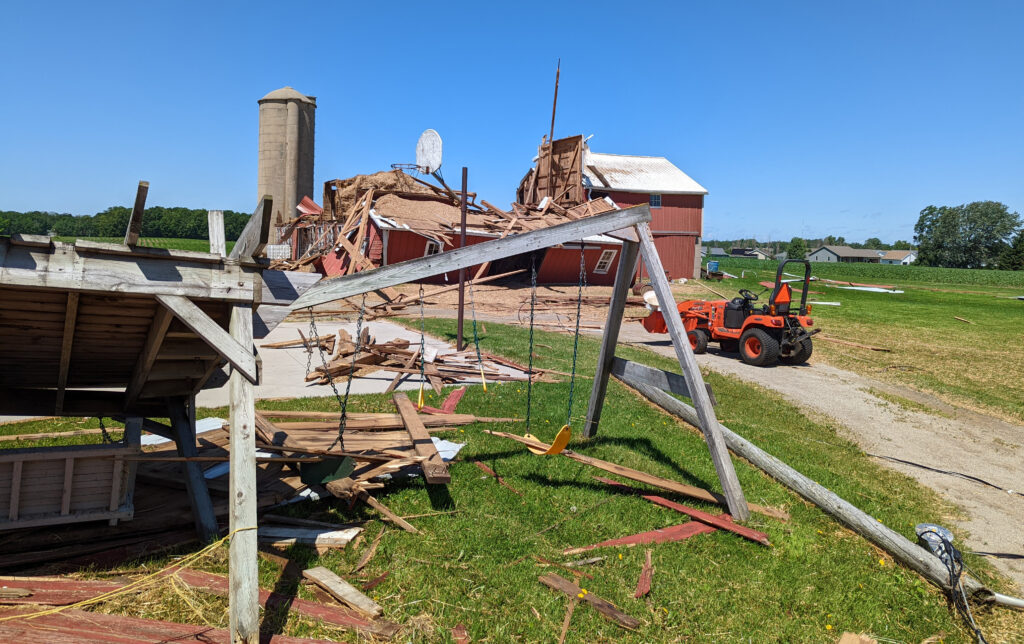By Brad Spakowitz
Correspondent
The start of the month brought mostly pleasant weather with comfortable temperatures, low humidity and several rain events, which helped nourish young crops and keep grass green.
But by mid-month, heat, humidity and severe weather took over the headlines.
The morning of June 14 started out foggy, damp and comfortable, with sun punching through the clouds in the early afternoon and temperatures quickly warming to 90 degrees.
After a muggy night, temperatures were quickly off to the races again the next day (June 15), topping out at a record high of 94 degrees, with a maximum heat index (real feel) of 101.
The stifling heat and humidity primed the atmosphere for a widespread round of severe weather late in the day, as a powerful cold front moved eastward across the state.

Severe weather
The cold front created an extensive line of strong and severe storms between 5-8 p.m. here, bringing heavy downpours, a few reports of hail and plenty of wind gusts in excess of 70 mph, causing countless reports of storm damage and power outages.
Embedded in the line of storms, several tornado spin-ups occurred, with a total of nine across Northeast Wisconsin.
The National Weather Service Green Bay office reported the first nearby tornado touched down around 6:10 p.m. in a cemetery just southwest of Black Creek in Outagamie County and traveled 9.37 miles east-northeast, grazing southern parts of Seymour before dissipating.
The tornado clocked-in as an EF-1 tornado with winds of 105 mph, creating widespread tree damage, some structure damage and snapping power poles east of Seymour.
That same tornado-producing storm traveled northeastward into Brown County, passing over far west Green Bay and Howard at 6:28 p.m., with radar estimated straight-line wind speeds of 90 mph.
Again, extensive damage occurred with downed trees and power lines, and even some building damage reported around Velp Avenue.
Moments later, the other nearby tornado touched down near Navarino in Shawano County, another EF-1, which caused similar storm damage.
Fortunately, through it all, no injuries or deaths were reported, but tree damage was extensive, and cleanup took days to weeks, and for some, power was not restored for five days.
Quiet, but hot and dry thereafter
Another blast of heat returned June 20, with a high of 95 degrees, and an even warmer 96 degrees on June 21, to officially welcome in the summer solstice.
The next two days were in the upper 80s, with another 94 degree reading arriving June 24, making five days in the month at or above 90 degrees – bringing the running total for the season to seven (two occurred in May).
The 30-year average for an entire year is 5.5 days with temperatures in the 90s.
The second half of the month was very dry, measuring just .43 inches of rain, leaving sunny lawns brown and keeping gardeners busy watering.
By the end of the month, a total of 2.82 inches of rain had fallen, 1.28 inches less than average.
Temperatures came in 2.6 degrees above the norm.
A look ahead to July
Average temperatures in July are nearly steady as we are at the apex of what is typically summer’s warmth.
The average high temperature July 1 is 80 degrees, the average low 59.
By July 31, the average high is 81 degrees and the low is 60.
July averages 3.62” of rain.
Now that we are beyond the summer solstice, days are getting shorter.
We experience a loss of 48 minutes of daylight during the month, with the July 31 sunrise at 5:37 a.m. and sunset at 8:18 p.m.
